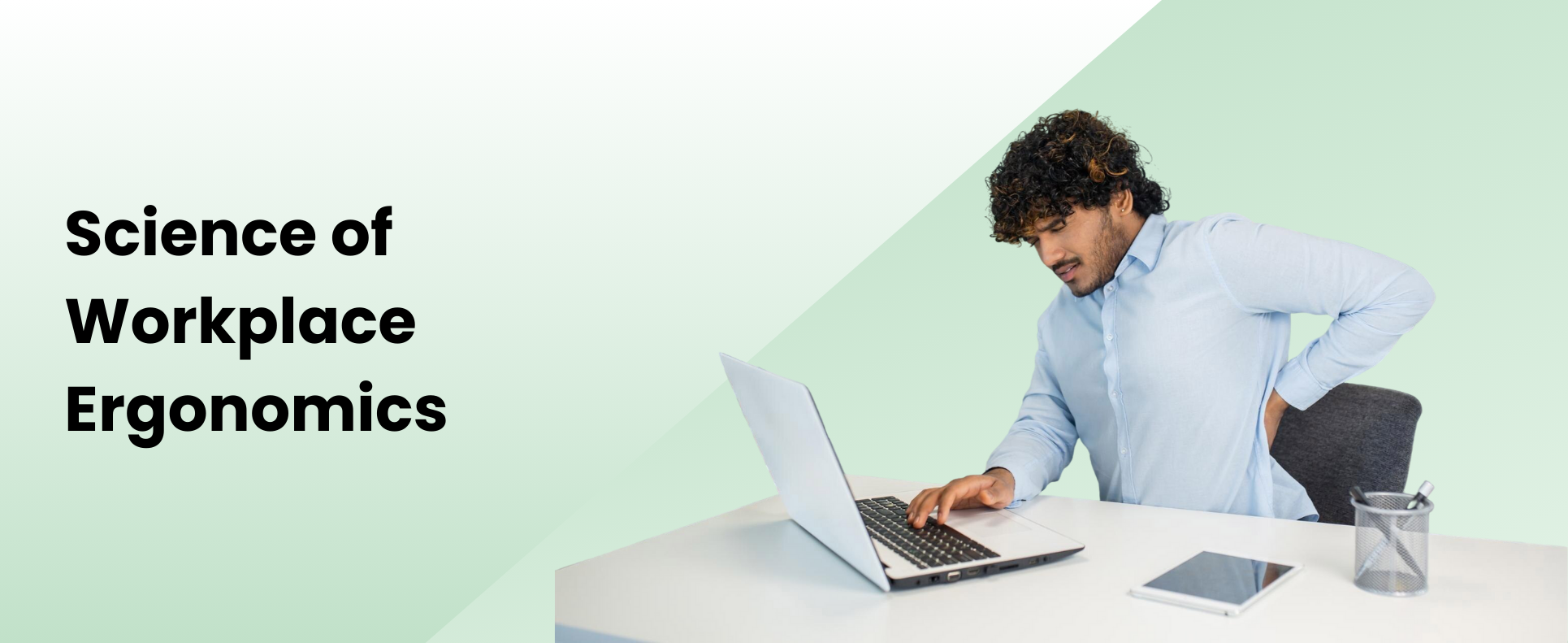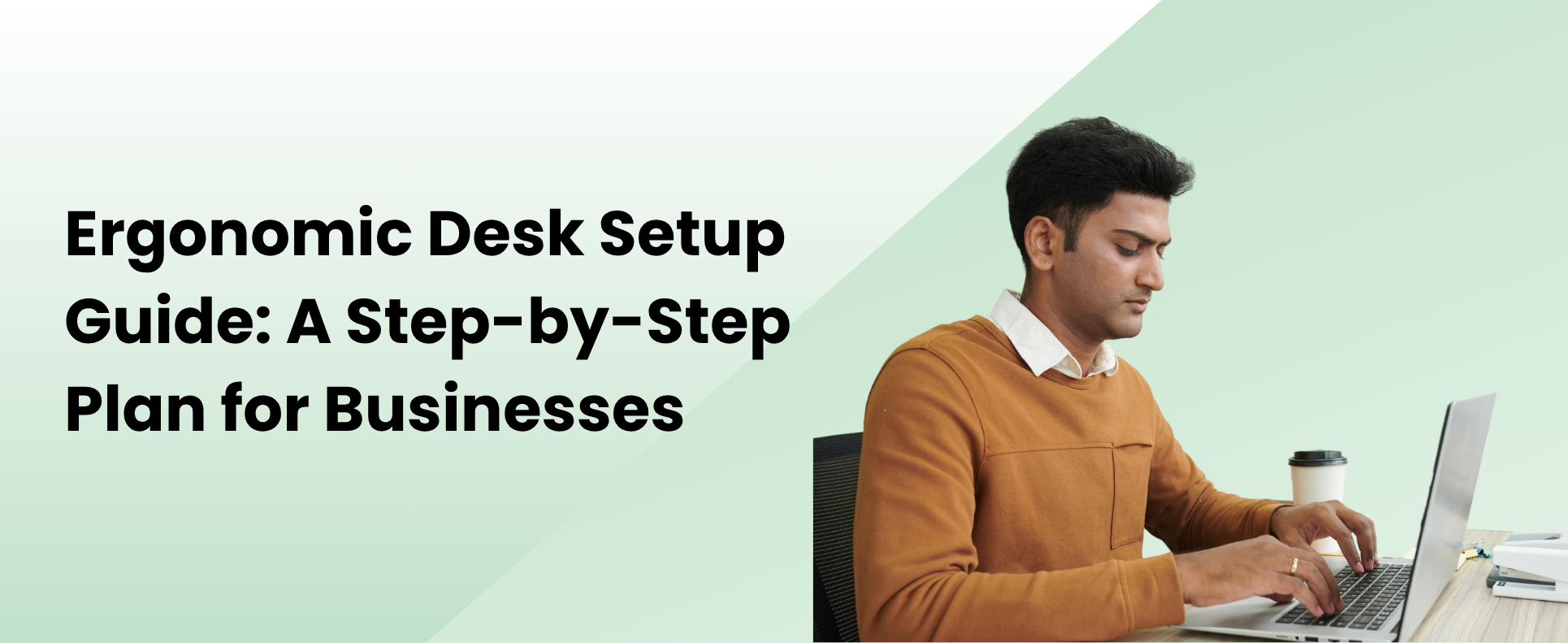19 May, 2025
The Science of Workplace Ergonomics: Preventing Injuries & Boosting Efficiency

Overview
Why Ergonomics Matters in Indian Workplaces?
In India’s fast-paced corporate environment, where long hours, desk-bound roles, and repetitive tasks dominate, ergonomics is more than a workplace upgrade. It’s a science-based approach to protecting employee health and improving operational efficiency.
Despite the increasing incidence of posture-related pain, many organisations still overlook ergonomics as a strategic investment. By grounding workplace design in scientific principles, businesses can reduce injuries, prevent burnout, and enhance team performance.
Workplace Risks
The Hidden Cost of Poor Ergonomics
Work-related musculoskeletal disorders (MSDs) are a growing concern in India, especially in sectors like IT, finance, manufacturing, and logistics. Common issues such as back pain, neck stiffness, wrist strain, and eye fatigue are often caused by:
According to recent studies, MSDs account for nearly 34% of all work-related illnesses in India, impacting not just health but also productivity and morale.
Scientific Backing
What Makes Ergonomics a Science?
Ergonomics applies scientific knowledge of human anatomy, biomechanics, and psychology to optimise workplace conditions. It’s not guesswork—it’s rooted in evidence from studies on human movement, joint loading, cognitive load, and physical fatigue.
For example:
- Biomechanics helps determine safe lifting techniques and tool design.
- Anthropometry ensures that workstations suit diverse body sizes and shapes.
- Physiology guides microbreaks and movement patterns to reduce muscle fatigue.
These principles prevent injuries by aligning tasks, tools, and environments with employees’ physical capabilities.
Efficiency Boost
How Ergonomic Improvements Drive Performance?
The benefits of ergonomic improvements extend far beyond injury prevention. A well-designed ergonomic environment can lead to:
.
Indian companies that introduced ergonomic redesigns have reported up to 32% improvement in productivity and a 48% reduction in MSD-related absenteeism within months. These tangible results directly impact business performance.
Evaluation Tips
How to Assess and Optimise Your Workplace Ergonomics?
Businesses often overlook simple signs of poor ergonomics—like frequent breaks due to discomfort, high turnover in specific roles, or recurring injury claims. Here’s how to identify and improve problem areas:
Conduct Ergonomic Risk Assessments
Evaluate workstation setup, repetitive motion risks, and posture strains across departments.
Survey Employees
Collect regular feedback on physical discomfort, eye strain, or fatigue patterns.
Use Movement Data
Observe movement patterns and break habits to identify areas for posture correction or task variation.
Trial and Adjust
Pilot ergonomic tools or changes (e.g., adjustable chairs, screen risers, footrests) and iterate based on feedback.
Investing in expert-led assessments—like those offered by BJM Health—ensures customisation and measurable outcomes.
Long-Term Value
Ergonomic Workspaces as a Strategic Asset
Ergonomics is not a one-time fix—it’s a long-term strategy that builds healthier, more resilient teams. Here’s what organisations stand to gain:
Lower healthcare costs due to fewer injuries.
Reduced turnover, as employees feel supported and valued.
Stronger employer brand, especially among younger, health-conscious talent.
Compliance with occupational safety standards and lower legal exposure.
Moreover, organisations that incorporate ergonomics into their culture through policies, training, and design are better positioned to scale sustainably.
Conclusion
Design Smarter, Work Better
Workplace ergonomics is a science-backed investment in both people and performance. As Indian companies face growing pressures around efficiency and employee wellbeing, ergonomics offers a proven path to healthier teams and better results.
Rather than waiting for injuries, proactive ergonomic planning ensures fewer sick days, higher morale, and sustained output, making it a health priority and a business advantage.
BJM Health: Your Ergonomic Health Partner
At BJM Health, we help Indian businesses implement practical, measurable, and impactful science-led ergonomic solutions. From posture analysis and workstation design to digital physiotherapy support, our programmes are tailored to prevent injuries and optimise performance.
Related Blogs
Seated Isometric Supination Press Relieve wrist and forearm strain with this simple seated isometric exercise. Duration: 2–3 mins Target Audience: Office/IT workers Goal: Wrist and forearm relief [...]
06 June, 2025 How Telehealth Can Enhance Employee Benefits & Improve Workplace Productivity? Overview Digital Healthcare as a Core Employee Benefit Telehealth is no [...]
05 June, 2025 How Telephysiotherapy Helps Indian Employees Recover from Workplace Injuries Faster Overview Why Telehealth Recovery Support Deserves Employer Focus? India’s workforce today [...]
02 June, 2025 Ergonomic Desk Setup Guide: A Step-by-Step Plan for Businesses Overview Why Desks Matter More Than You Think? In the modern Indian [...]






